Ultimate Guide to Kimono Photo Shoots in Kyoto
Everything You Need to Know in 2025
Experience the magic of traditional Japanese culture through professional kimono photography in Japan’s ancient capital
- What Makes Kyoto Perfect for Kimono Photography?
- Complete Step-by-Step Kimono Photo Shoot Experience
- Best Kimono Photo Shoot Locations in Kyoto
- Professional Tips for Perfect Kimono Photos
- Pricing and Packages Guide
- Seasonal Considerations for Your Shoot
- Ready to Book Your Kyoto Kimono Photo Shoot?
- Frequently Asked Questions
- How long does a typical kimono photo shoot in Kyoto take?
- What should I wear under the kimono?
- Can I choose my own photography locations?
- Is the kimono photo shoot suitable for all ages?
- What happens if it rains during my photo shoot?
- How far in advance should I book my kimono photo shoot?
- Are the digital photos included in the package price?
- Can I bring my own photographer?
- Experience authentic Japanese culture through professional kimono photography in Kyoto.
What Makes Kyoto Perfect for Kimono Photography?
Kyoto stands as Japan’s cultural heart, offering an unparalleled backdrop for kimono photo shoots. With over 2,000 temples and shrines, traditional wooden architecture, and meticulously maintained gardens, this ancient capital provides the perfect setting for capturing the elegance of traditional Japanese attire.
The city’s rich history spans over 1,000 years, making it an authentic location where kimono photography in Kyoto feels natural and meaningful. Unlike other tourist destinations, Kyoto maintains its traditional atmosphere while offering modern conveniences for professional photography services.
Why Choose Professional Kimono Photography in Kyoto?
Professional kimono photo shoots in Kyoto offer several advantages over DIY attempts:
- Expert kimono fitting by trained professionals who understand proper layering techniques
- Traditional makeup and hairstyling that complements the kimono’s aesthetic
- Location expertise from photographers familiar with Kyoto’s hidden gems
- Cultural authenticity that respects Japanese traditions and customs
- High-quality results that capture both beauty and cultural significance
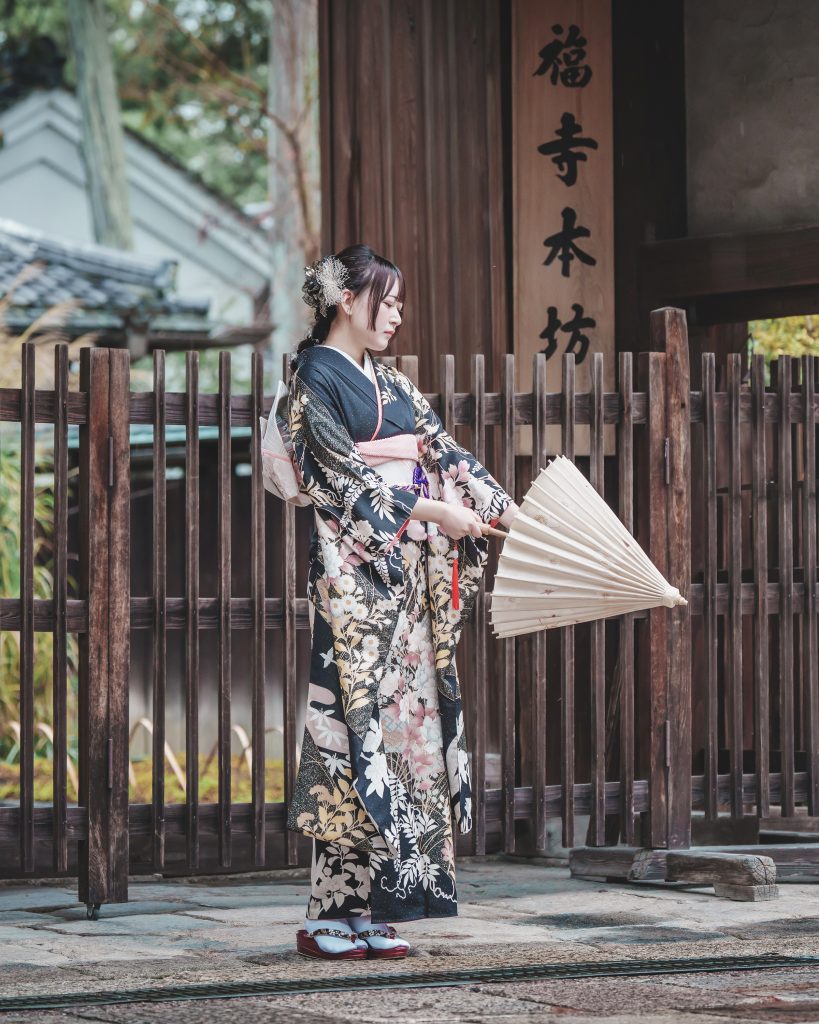
Complete Step-by-Step Kimono Photo Shoot Experience
Step 1: Traditional Kimono Selection and Fitting
Your Kyoto kimono photo shoot begins with selecting from an extensive collection of authentic garments. Professional rental shops in Kyoto maintain hundreds of kimonos in various styles, colors, and patterns to suit every preference and season.
What to expect during kimono fitting:
- Selection process: Choose from formal furisode, elegant houmongi, or casual komon styles
- Color coordination: Expert staff help match colors to your complexion and the chosen photography locations
- Proper layering: Experience authentic Japanese dressing techniques with multiple layers including juban (undergarment), kimono, and obi (sash)
- Accessory selection: Complete your look with traditional accessories like obidome (obi ornaments), kanzashi (hair ornaments), and tabi (split-toe socks)
- Comfort adjustments: Ensure proper fit for extended wear during your photo session
The fitting process typically takes 30-45 minutes, allowing time to perfect every detail. Professional dressers understand how to balance authenticity with comfort, ensuring you can move gracefully throughout your kimono photo shoot in Kyoto.
Step 2: Professional Hair and Makeup Styling
Traditional Japanese beauty emphasizes natural elegance and harmony. Professional stylists specializing in kimono photography create looks that complement both your features and the chosen garment.
Hair styling options include:
- Traditional updos: Classic styles like shimada or tsubushi that showcase the kimono’s neckline
- Modern adaptations: Contemporary versions of traditional styles suitable for various face shapes
- Seasonal elements: Incorporation of seasonal flowers or ornaments appropriate to the time of year
- Hair accessories: Traditional kanzashi, combs, and pins that enhance the overall aesthetic
Makeup application focuses on:
- Natural enhancement: Subtle techniques that highlight your best features
- Traditional elements: Classic looks inspired by geisha and maiko styling
- Photography optimization: Makeup that photographs beautifully in various lighting conditions
- Long-lasting formulas: Products chosen to maintain their appearance throughout the shoot
Step 3: Guided Photography Tour of Kyoto’s Most Photogenic Locations
Professional Kyoto kimono photographers know the city’s most stunning locations and optimal timing for each shot. Your guided tour includes multiple stops at carefully selected sites that showcase both your kimono and Kyoto’s beauty.
Historic Temples and Shrines
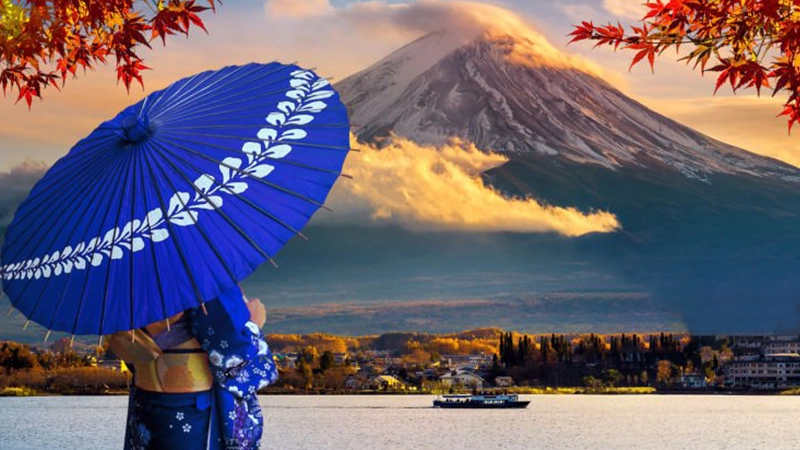
- Kinkaku-ji (Golden Pavilion): Iconic golden temple reflecting in surrounding ponds
- Fushimi Inari Shrine: Famous for thousands of vermillion torii gates
- Kiyomizu-dera: Wooden temple offering panoramic city views
- Yasaka Shrine: Traditional shrine in the heart of Gion district
Traditional Districts
- Gion: Historic geisha district with preserved wooden buildings
- Higashiyama: Stone-paved streets lined with traditional shops
- Arashiyama: Bamboo groves and mountain scenery
- Pontocho Alley: Narrow alley with traditional restaurants and tea houses

Gardens and Natural Settings
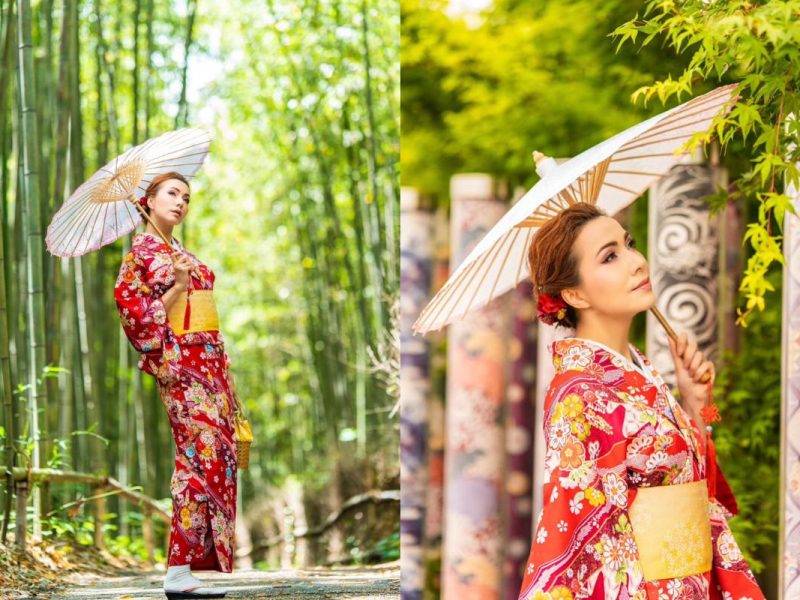
- Maruyama Park: Especially beautiful during cherry blossom season
- Ryoan-ji: Famous zen rock garden providing minimalist backdrops
- Kyoto Botanical Garden: Diverse plant collections for varied seasonal shots
- Philosopher’s Path: Tree-lined walking path along a canal
Step 4: Professional Photography Session
Working with experienced kimono photographers in Kyoto ensures your images capture both technical excellence and cultural authenticity. These professionals understand how to pose subjects in kimono to showcase the garment’s elegant lines while creating flattering portraits.
Photography techniques include:
- Posing guidance: Direction on traditional poses that complement kimono wearing
- Movement coaching: How to walk and gesture gracefully in traditional attire
- Angle optimization: Capturing the kimono’s design details and overall silhouette
- Lighting expertise: Utilizing natural light to enhance colors and textures
- Cultural sensitivity: Respectful photography that honors Japanese traditions
Step 5: Photo Review and Selection
Your Kyoto kimono photo shoot concludes with a collaborative review of the captured images. This process allows you to select favorite shots for professional editing and choose delivery formats.
Photo review includes:
- Initial selection: Reviewing all captured images to identify the best shots
- Editing options: Understanding available retouching and enhancement services
- Format choices: Selecting between digital delivery, prints, or photo albums
- Timeline discussion: Understanding processing and delivery schedules
- Additional services: Options for rush processing or special printing
Best Kimono Photo Shoot Locations in Kyoto
Seasonal Location Recommendations
Spring (March-May) – Cherry Blossom Season

- Maruyama Park: Peak sakura viewing with traditional picnic settings
- Philosopher’s Path: Canal-side cherry trees creating natural tunnels
- Yoshino-yama: Hillside temples surrounded by blooming trees
- Daigo-ji Temple: Extensive grounds with various cherry blossom varieties
Summer (June-August) – Lush Greenery
- Arashiyama Bamboo Grove: Cool, green tunnels perfect for summer shoots
- Kyoto Botanical Garden: Diverse plant collections and shaded areas
- Sanzen-in Temple: Mountain temple with moss gardens
- Kurama-dera to Kibune hike: Mountain trails with forest backgrounds
Autumn (September-November) – Fall Foliage
- Tofuku-ji Temple: Famous for spectacular autumn maple colors
- Eikan-do Temple: Known as “Maple Leaf Temple” for its fall beauty
- Kiyomizu-dera: Wooden terraces overlooking colorful valley
- Jojakkoji Temple: Intimate temple with stunning fall gardens

Winter (December-February) – Snow and Minimalism
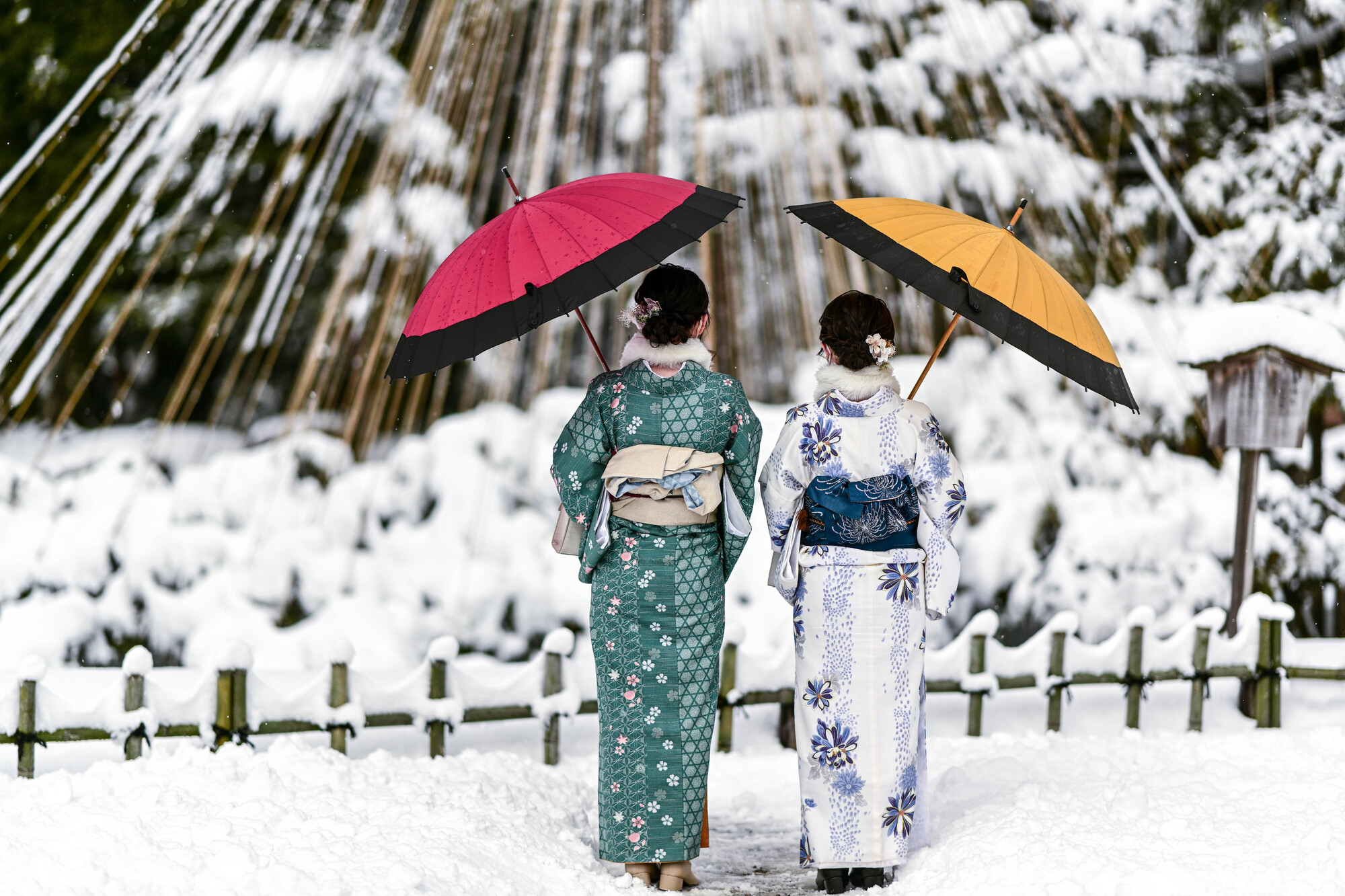
- Kinkaku-ji: Golden Pavilion dramatically enhanced by snow
- Ryoan-ji: Zen rock garden with snow-covered stones
- Ginkaku-ji: Silver Pavilion and gardens in winter tranquility
- Nanzen-ji: Large temple complex with winter mountain views
Hidden Gem Locations for Unique Photos
Professional kimono photographers in Kyoto often know lesser-known locations that provide unique backdrops without crowds:
- Sanneizaka and Ninenzaka: Historic stone steps with traditional architecture
- Ishibei-koji Lane: Preserved historic street in Higashiyama
- Shirakawa area: Traditional machiya (wooden houses) along a canal
- Kennin-ji Temple: Zen temple with beautiful gardens and traditional architecture
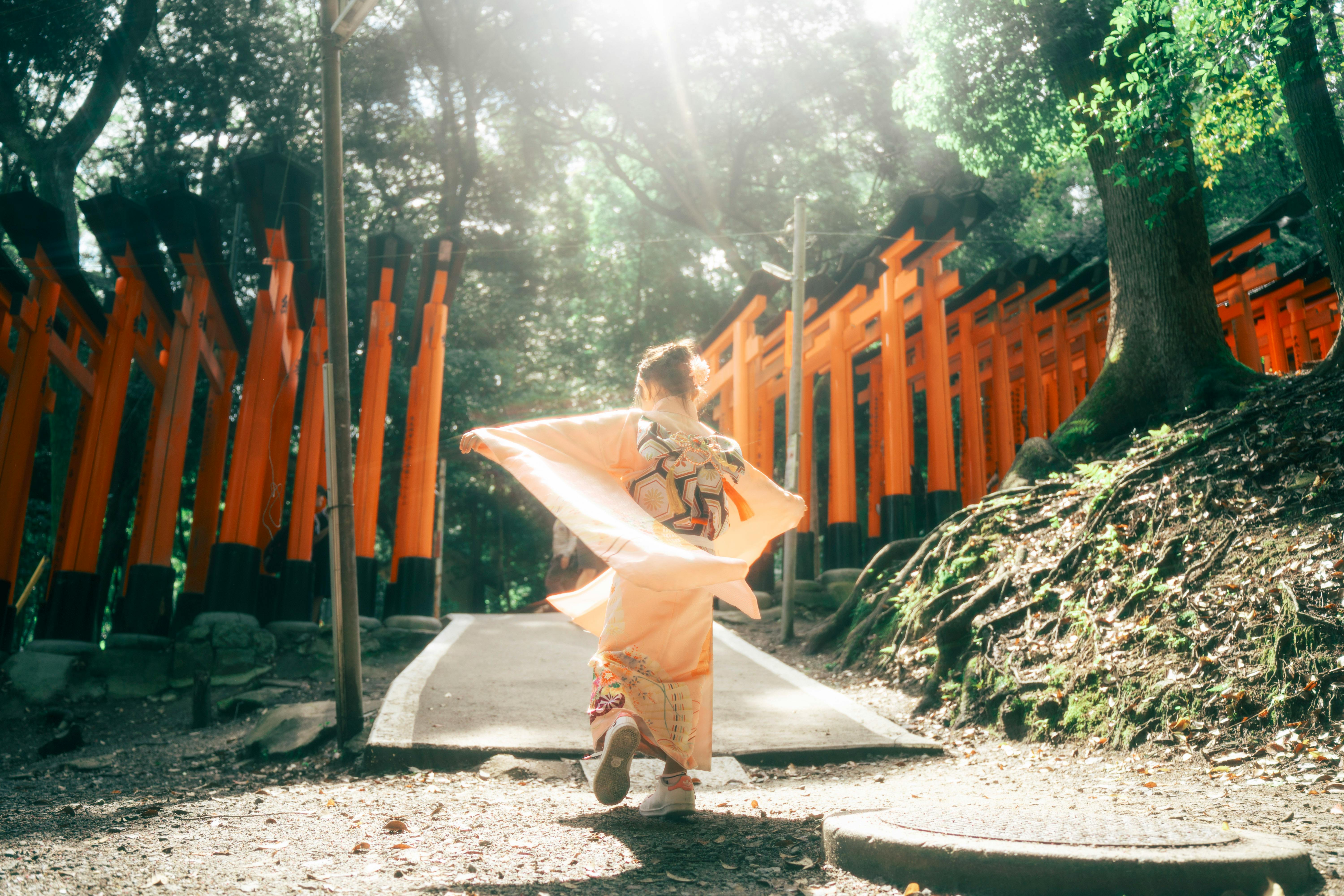
Professional Tips for Perfect Kimono Photos
Posing and Movement in Kimono
Traditional kimono posing requires understanding of the garment’s structure and cultural significance. Professional photographers guide subjects through poses that enhance the kimono’s elegant lines while creating flattering portraits.
Key posing principles:
- Posture: Maintain straight spine and relaxed shoulders for elegant silhouette
- Hand placement: Traditional positions that complement kimono sleeves and obi
- Foot positioning: Proper stance that showcases the kimono’s length and design
- Facial expressions: Natural, serene expressions that match the kimono’s elegance
- Movement: Graceful walking and turning techniques for dynamic shots
Photography Technical Considerations
Professional kimono photography requires specific technical knowledge to capture the garment’s textures, colors, and details effectively.
Technical aspects include:
- Lighting: Utilizing natural light to enhance silk textures and vibrant colors
- Composition: Framing shots to showcase both subject and traditional backgrounds
- Focus: Ensuring sharp detail on intricate kimono patterns and accessories
- Color accuracy: Maintaining true colors of expensive silk fabrics
- Depth of field: Creating separation between subject and background
Cultural Sensitivity and Respect
Respectful kimono photography honors Japanese culture while creating beautiful images. Professional services understand cultural protocols and ensure appropriate behavior throughout the experience.
Cultural considerations:
- Sacred spaces: Understanding photography restrictions at temples and shrines
- Traditional etiquette: Proper behavior when wearing kimono in public spaces
- Local customs: Respecting local residents and avoiding disruption
- Authentic representation: Avoiding cultural appropriation through respectful presentation
- Educational approach: Learning about kimono history and significance
Pricing and Packages Guide
Standard Kimono Photo Shoot Packages
Basic Package
¥15,000-25,000
- • Kimono rental for 3-4 hours
- • Basic hair styling and makeup
- • 1-2 location shoots
- • 20-30 edited digital photos
- • Basic accessories included
Premium Package
¥30,000-45,000
- • High-quality kimono selection
- • Professional hair styling and makeup
- • 3-4 location shoots with guided tour
- • 50-80 edited digital photos
- • Premium accessories and styling options
- • Same-day photo preview
Luxury Package
¥50,000-80,000
- • Designer kimono collection access
- • Professional makeup artist and hair stylist
- • Private photography tour (4-6 hours)
- • 100+ edited digital photos
- • Professional photo album
- • Rush processing available
- • Personal assistant throughout the day
Additional Services and Add-ons
Photography Extensions:
- • Extra hour of shooting: ¥8,000-12,000
- • Additional locations: ¥5,000-8,000 per location
- • Sunrise or sunset shoots: ¥10,000-15,000 premium
Product Options:
- • Professional photo album: ¥15,000-25,000
- • Large format prints: ¥3,000-8,000 each
- • Digital photo album: ¥8,000-12,000
- • Rush editing (24-48 hours): ¥10,000-15,000
Seasonal Pricing Considerations
Peak Season Premiums (Cherry Blossom & Fall Foliage):
- • 20-30% premium during peak cherry blossom season (early April)
- • 15-25% premium during peak fall foliage (mid to late November)
- • Advanced booking required (2-3 months in advance)
- • Limited availability during peak periods
Off-Season Advantages:
- • 10-15% discounts during winter months (excluding New Year period)
- • Better availability and flexibility with scheduling
- • Less crowded locations for photography
- • More personalized attention from photographers
Seasonal Considerations for Your Shoot
Spring Cherry Blossom Season (March-May)
Peak Cherry Blossom Period typically occurs in early April, making this the most popular time for kimono photo shoots in Kyoto. The combination of blooming sakura trees and traditional kimono creates quintessentially Japanese imagery.
Spring considerations:
- Weather: Mild temperatures perfect for extended outdoor photography
- Crowds: Expect larger crowds at popular locations, especially during peak bloom
- Booking: Reserve your session 2-3 months in advance
- Kimono colors: Pastel and floral patterns complement cherry blossoms beautifully
- Timing: Early morning shoots avoid crowds and capture soft lighting
Summer Green Season (June-August)
Summer in Kyoto offers lush greenery and vibrant natural backgrounds, though higher temperatures and humidity require special considerations for kimono photography.
Summer strategies:
- Early morning shoots: Avoid peak heat and harsh lighting
- Location selection: Choose shaded areas and indoor/outdoor combinations
- Hydration: Regular breaks and water consumption essential
- Kimono choices: Lighter fabrics and colors for comfort
- Makeup considerations: Heat-resistant formulas for extended wear
Autumn Foliage Season (September-November)
Fall in Kyoto provides spectacular color combinations with red maple leaves, golden ginkgo trees, and traditional architecture creating stunning backdrops for kimono photography.
Autumn advantages:
- Comfortable temperatures: Ideal weather conditions for extended shoots
- Spectacular colors: Natural autumn palette complements traditional kimono designs
- Clear skies: Generally excellent weather for outdoor photography
- Varied locations: Multiple foliage spots throughout the city
- Extended season: Fall colors last several weeks unlike brief cherry blossom period
Winter Elegance Season (December-February)
Winter kimono photography offers unique opportunities with snow-covered temples, minimalist compositions, and the dramatic contrast between colorful kimono and monochromatic winter landscapes.
Winter considerations:
- Cold weather preparation: Proper undergarments and warming breaks
- Snow opportunities: Some of Kyoto’s most dramatic photography occurs during snowfall
- Indoor alternatives: Beautiful interior shots at temples and traditional buildings
- Lighting challenges: Shorter days require careful timing and location planning
- Unique aesthetics: Winter creates distinctive mood and atmosphere
Ready to Book Your Kyoto Kimono Photo Shoot?
Experience the magic of traditional Japanese culture through professional kimono photography in Kyoto’s most beautiful locations. Our expert team provides comprehensive services from authentic kimono fitting to professional photography, ensuring your Kyoto kimono photo shoot creates lasting memories of Japan’s cultural heart.
Book your unforgettable kimono photography experience today at AllPhoto Kyoto
Our professional photographers specialize in capturing the elegance of traditional Japanese attire against Kyoto’s most stunning backdrops. Whether you’re visiting during cherry blossom season, autumn foliage, or any time throughout the year, we’ll create beautiful images that showcase both your personal style and Japan’s timeless beauty.
Frequently Asked Questions
How long does a typical kimono photo shoot in Kyoto take?
A complete kimono photo shoot experience typically lasts 3-4 hours, including:
- 30-45 minutes for kimono selection and fitting
- 30 minutes for professional hair styling and makeup
- 2-2.5 hours for photography at multiple locations
- 15-30 minutes for photo review and selection
Extended packages may last 5-6 hours for more comprehensive coverage of Kyoto’s photography locations.
What should I wear under the kimono?
For comfort and proper fit, wear:
- Light, plain-colored underwear (avoid visible lines)
- Comfortable, low-profile bra or sports bra
- Thin, close-fitting leggings or shorts
- Avoid bulky clothing that might create lumps under the kimono layers
The rental shop typically provides traditional undergarments (juban) as part of the fitting service.
Can I choose my own photography locations?
Most professional Kyoto kimono photography services offer location flexibility:
- Standard packages include pre-selected popular locations
- Custom location requests often accommodated with advance notice
- Some locations may require special permits or additional fees
- Photographers provide expert recommendations based on season, lighting, and crowd conditions
Is the kimono photo shoot suitable for all ages?
Kimono photography in Kyoto welcomes participants of all ages:
- Children’s kimono available for family sessions
- Teen-friendly styles and modern accessories
- Adult formal and casual options
- Senior-friendly comfortable fitting and shorter sessions available
What happens if it rains during my photo shoot?
Professional services have contingency plans for weather:
- Indoor photography locations at temples and traditional buildings
- Covered outdoor areas like temple corridors and traditional architecture
- Rescheduling options for severe weather
- Umbrellas and protective coverings for light rain photography
How far in advance should I book my kimono photo shoot?
Booking recommendations:
- Peak seasons (cherry blossom, fall foliage): 2-3 months advance booking
- Regular seasons: 2-4 weeks advance booking recommended
- Last-minute bookings: Sometimes available, especially weekdays and off-season
- Group bookings: Require more advance notice for coordination
Are the digital photos included in the package price?
Most Kyoto kimono photo shoot packages include:
- Edited digital photos delivered via online gallery
- Basic retouching and color correction included
- Additional editing services available for extra fee
- Print services and photo albums as optional add-ons
Can I bring my own photographer?
While some kimono rental shops allow external photographers:
- Additional fees may apply for kimono rental only
- Professional guidance on posing and cultural aspects may be limited
- Location access and timing coordination become your responsibility
- Insurance and permit requirements may need separate arrangement
Experience authentic Japanese culture through professional kimono photography in Kyoto.
Book your session today and create timeless memories in Japan’s ancient capital.
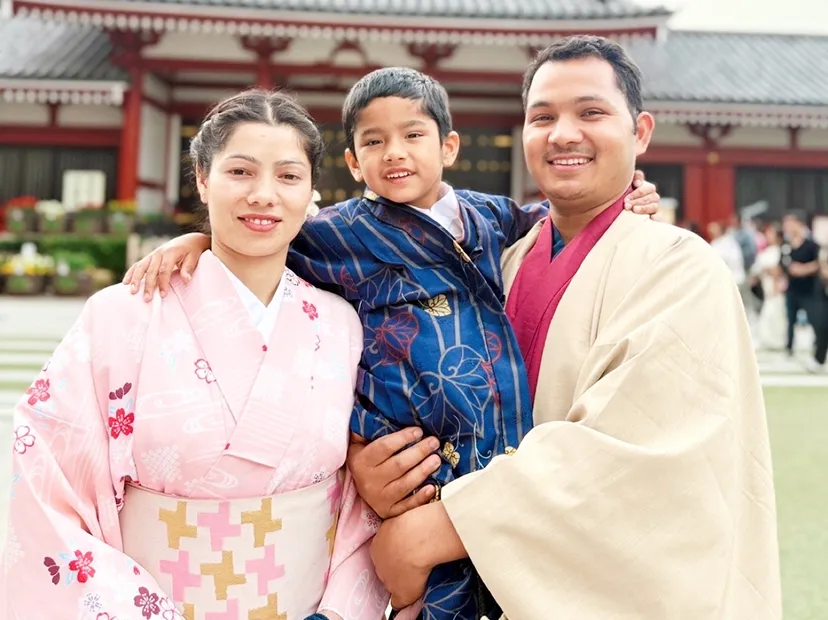


コメント